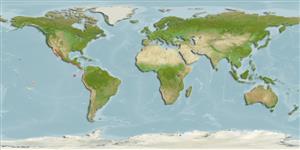Actinopterygii (ray-finned fishes) >
Anguilliformes (Eels and morays) >
Ophichthidae (Snake eels) > Ophichthinae
Etymology: Myrichthys: Greek, myros, -ou = male of morey eel + Greek, ichthys = fish (Ref. 45335). More on author: Girard.
Environment / Climate / Range
Ecology
Marine; reef-associated; depth range 0 - 60 m (Ref. 5227). Tropical, preferred ?; 32°N -
Eastern Pacific: Gulf of California to Peru, including the Galapagos Islands.
Size / Weight / Age
Maturity: Lm ? range ? - ? cm
Max length : 74.0 cm TL male/unsexed; (Ref. 5227); common length : 60.0 cm TL male/unsexed; (Ref. 55763)
Inhabits sandy and muddy bottoms, from shallow waters up to a depth of 25 m. Can be seen at times in daylight searching for prey under rocks and in crevices over rocky bottoms, or buried completely in the sand when inactive (Ref. 6852).
Life cycle and mating behavior
Maturity | Reproduction | Spawning | Eggs | Fecundity | Larvae
McCosker, J.E. and R.H. Rosenblatt, 1995. Ophichthidae. Tiesos, serpentones. p. 1326-1341. In W. Fischer, F. Krupp, W. Schneider, C. Sommer, K.E. Carpenter and V. Niem (eds.) Guia FAO para Identification de Especies para lo Fines de la Pesca. Pacifico Centro-Oriental. 3 Vols. FAO, Rome. (Ref. 9328)
IUCN Red List Status (Ref. 115185)
CITES (Ref. 94142)
Not Evaluated
Threat to humans
Harmless
Human uses
Fisheries: of no interest
More information
Common namesSynonymsMetabolismPredatorsEcotoxicologyReproductionMaturitySpawningFecundityEggsEgg development
Age/Size
Growth
Length-weight
Length-length
Length-frequencies
Morphometrics
Morphology
Larvae
Larval dynamics
Recruitment
Abundance
ReferencesAquacultureAquaculture profileStrainsGeneticsAllele frequenciesHeritabilityDiseasesProcessingMass conversion
Tools
Special reports
Download XML
Internet sources
